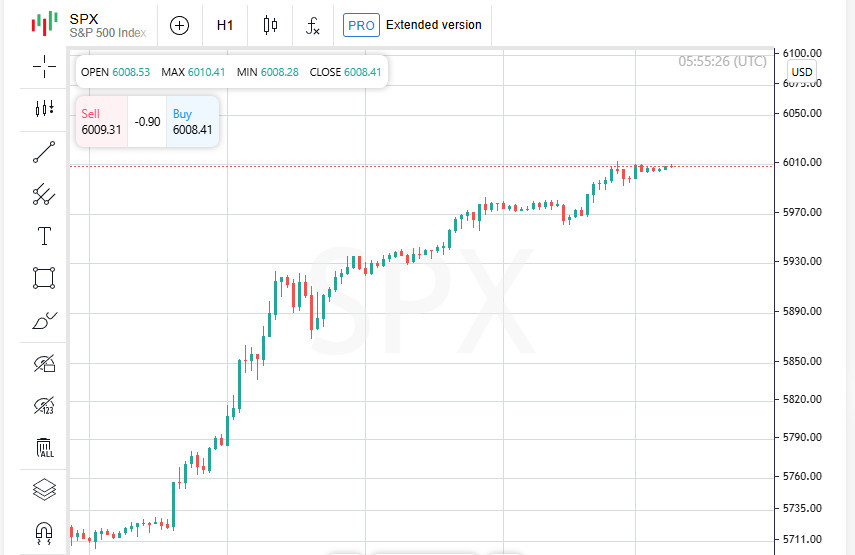Markets Riding: Trump, Fed Rates Fuel Optimism
The S&P 500 briefly crossed 6,000 on Friday night, ending the week with its biggest gain of the year. Trump and his political outlook had a powerful impact on investor sentiment, raising hopes for favorable economic reforms.
Economic impact of rate cuts
Expectations of a 25 basis point rate cut announced by the Federal Reserve this week have added confidence to stock markets. The Fed's actions have increased the appetite for growth, which could not but be reflected in the performance of stock indices.
The S&P 500 and the Dow Jones Industrial Average (DJIA) recorded their best weekly results since November 2023. Nasdaq, in turn, demonstrated its best week in two months, strengthening amid growing expectations for economic growth and higher corporate earnings.
Political changes: what does a Republican victory promise?
One of the key factors influencing stock markets has become the political situation in the United States. Donald Trump's victory in the election and the possible control of the Republican Party over the Senate and the House of Representatives create the preconditions for stabilization of the political situation. Many believe that this will facilitate the implementation of ambitious plans for tax cuts and deregulation, which in turn stimulates the growth of corporate profits and investment.
Trump and Tax Reform
Corporate tax cuts and deregulation were the main drivers of the Nasdaq's rally, with three straight days of record closings. As a result, the S&P 500 ended the week with its 50th record close this year, underscoring the strength of the current bullish trend.
Mike Dixon, head of research and quantitative strategy at Horizon Investments, said: "While the 6,000 mark is psychologically significant, given all the events of the week, I don't think it matters whether we close at 6,005 or 5,995. The market still put up an impressive gain."
So, it's been a very positive week for stock indices, with major events like the election and the Fed decision continuing to impact financial markets, creating positive expectations for investors.
Markets in the green: News that influenced the rally
This week brought a lot of positive news for stock markets, with investors reacting strongly to the improvements in the economy and politics. As one analyst emphasized, "this flow of good news is much more important than whether the indicator will be at 6000 or slightly below when the market closes." All this prevails over technical issues, highlighting the strong optimism among traders.
Indices on the rise: Dow at a record
The Dow Jones Industrial Average jumped 259.65 points (0.59%), ending the day at 43,988.99. The S&P 500 added 22.44 points (0.38%), closing at 5,995.54, and the Nasdaq Composite rose 17.32 points (0.09%), reaching 19,286.78.
All three indices posted impressive gains for the week, with the S&P 500 up 4.66%, the Nasdaq up 5.74%, and the Dow up 4.61%.
Records and Strong Sectors
One of the highlights of the week was the Dow's historic performance, which surpassed the 44,000 mark for the first time. Salesforce stood out among the growth drivers, with shares rising 3.59% on the back of the company's plans to hire 1,000 new employees to expand its artificial intelligence business through its Agentforce tool.
Interest rate-sensitive sectors such as real estate and utilities were the best performers among the 11 S&P 500 groups. This came as Treasury yields continued to decline for a second session after a sharp jump in the wake of political events.
Fourth consecutive gain
The S&P 500 and Nasdaq ended the week on a positive note, recording a fourth consecutive gain. This confirms that investors are confident that the market will continue to strengthen, despite possible political and economic risks.
Thus, the week turned out to be especially favorable for stock markets, supported by positive news, strengthening of large companies and lower rates, which together gave a strong impetus for further growth.
Market Trends: Yields and Tariffs
Despite positive moves in stock markets, the benchmark 10-year U.S. Treasury yield remained at a four-month high. This weighed on investors' expectations for the pace of rate cuts by the Federal Reserve in 2025. Markets adjusted their forecasts amid growing concerns about the administration's proposed tariffs, which could reignite inflationary pressures.
Russell 2000: Small-cap stocks post strong gains
The Russell 2000 index of small-cap stocks posted a phenomenal 8.51% gain for the week, the biggest weekly gain since April 2020. Experts believe that stocks focused on the domestic U.S. market are benefiting from favorable economic conditions, such as potential tax relief, less regulation, and less reliance on foreign trade and tariffs.
Consumer Optimism
US consumer sentiment indicators hit a seven-month high in early November, with the household expectations index rising in particular, reaching its highest in three years. Republicans are optimistic about the economic outlook, which is having a noticeable impact on confidence, according to the University of Michigan Consumer Sentiment Index.
Problems in the Tech Sector
Despite the overall market growth, several large companies saw a noticeable decline. For example, Airbnb shares fell by 8.66% after the company failed to meet investors' expectations for third-quarter profit. Pinterest fared even worse, with its shares falling by 14% after disappointing revenue forecasts.
Chinese Companies: Declining Interest
Chinese companies' listings on US exchanges also lost value. Investors did not appreciate the latest fiscal support measures from the Chinese government. For example, JD.com shares fell by 6.99%, while Alibaba lost 5.94%.
Market Leaders and Losers
Amid these fluctuations, rising stocks significantly outnumbered falling stocks. The ratio was 1.7 to 1 on the New York Stock Exchange and 1.21 to 1 on the Nasdaq, indicating that positive sentiment prevailed among investors despite some setbacks in large companies.
Markets on the Rise: New Records and Growing Volumes
The S&P 500 Index recorded 88 new 52-week highs and only 10 lows, while the Nasdaq Composite surpassed the 211 new records mark despite 108 lows. Total trading volume on U.S. exchanges amounted to 15.46 billion shares, which was significantly higher than the average of 12.74 billion over the past 20 trading days.
The Fed and Expectations of Rate Cuts
Amid these records, positive economic forecasts from the Federal Reserve supported market sentiment. On Thursday, it announced a long-awaited 25 basis point interest rate cut, helping to bolster investor confidence. But the key question is how long the central bank can maintain this stance, as its actions will depend on how effectively inflation is brought down.
Inflation and Growth Expectations
The November 13 consumer price index report should confirm that inflation is continuing to decline, according to Art Hogan, chief market strategist at B Riley Wealth. U.S. inflation data has been an important indicator in recent months for the Fed as it tries to balance its policy between stimulating the economy and controlling prices.
Trump and Potential Tariffs: Risks to Prices
However, investors are concerned about potential tariff hikes proposed as part of Donald Trump's program, which could put pressure on consumer prices and add uncertainty to the economy. Meanwhile, economic data continues to surprise, with a recent report showing the U.S. economy grew by a robust 2.8% in the third quarter, another positive sign.
CPI forecasts: Moderate growth
Economists forecast the consumer price index (CPI) to rise 2.6% in October from a year earlier. That's up slightly from the 2.4% gain in September, which was the slowest in three years. Still, that pace remains well below the peak inflation levels seen in 2022 that prompted the Fed to raise rates sharply.
Inflation Impact on Fed Rates: New Forecasts
As inflation rises, perceptions of how the Federal Reserve will adjust rates in the future are changing. Market expectations have changed significantly since Donald Trump's election victory. According to federal funds futures, investors now expect rates to be cut to 3.7% by the end of 2025, up 100 basis points from September's estimate. These forecast revisions are based on new economic and political realities.
Rate Cuts as Growth Drivers
Expectations of future rate cuts are playing a major role in supporting growth stocks, along with strong corporate earnings results and optimism about artificial intelligence. Investors are betting that easy monetary policy will continue to spur growth, especially in sectors that are actively using new technologies and innovation.
Markets brace for more policy changes
However, the initial euphoria in the markets may come under pressure as Trump begins to reveal specific policy plans and appoint key figures. According to analysts at UBS Global Wealth Management, Trump's victory so far raises more questions than answers for investors. With each new statement from the presidential transition team, markets will test how these changes will affect the economy and financial flows.
Regulation and Opportunities for Wall Street
The expected policy changes have also generated waves of anticipation in the banking and financial sectors. In particular, financial institutions are counting on the loosening of regulations under the new administration. Wall Street is actively preparing to seize this opportunity, hoping for more lenient financial policies that will give impetus to further development and profit growth.
Trump and Lobbyists: Preparing for Regulatory Changes
After Donald Trump's election victory, financial trade groups are busy compiling lists of changes that they want to propose to the new president's transition team. Industry sources, speaking on condition of anonymity, say a list of proposals covering key regulatory issues is already being actively developed for delivery to Trump's team.
Industry Ready for Action
The process is the result of months of discussions between the transition team and various industry groups, lawyers, and lobbyists. The goal of these meetings, the sources say, is to lay the groundwork for implementing Trump's promises when he potentially returns to the White House in 2025. Reflecting the importance of these initiatives, several trade groups are willing to submit their proposals urgently.
Room for Aggressive Moves
The intensity of preparations for potential regulatory changes underscores the new administration's desire to act quickly and decisively, especially in key areas such as banking, where debate has already emerged over future rules and regulations.
Bank Groups Oppose Basel III Endgame
A major concern in the banking industry is the proposed Basel III Endgame rules, which would require large banks to hold significantly more capital to mitigate risk. The measures have already drawn criticism from banking groups, which have lobbied for months to reduce the requirements. Now they are hoping that the new administration will either roll back the rules or offer more flexible changes to ease the burden on financial institutions.
Banks Want Easier Regulation
U.S. banks are actively seeking ways to ease regulations, especially on issues that currently cause them the most trouble. The banks want relief from some tough requirements, including fair lending rules, which they continue to fight in court, according to sources. In addition, the financial institutions are pushing for easier annual stress tests for large banks and easier evaluation of mergers and acquisitions.
Easy Capital and Basel
Large U.S. lenders say that while they support the core principles of the Basel standards, the international norms for the banking industry, they want more flexible capital requirements. The changes would allow banks to stay within existing rules but reduce the burden on banks by allowing them more flexibility in decision-making, people familiar with the matter said. Discussions on the issues are still ongoing, and lobbying efforts are in the early stages.
Banking Regulatory Issues
Another major issue for banks is the tightening of their oversight by the Consumer Financial Protection Bureau (CFPB). Under Rohit Chopra, the agency has stepped up enforcement efforts, causing further concern in the banking community. The CFPB is becoming a major focus for lobbyists seeking to soften the impact of such initiatives on banking institutions.












